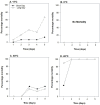Influence of Temperature and Photoperiod on Survival and Development of Eoreuma loftini (Lepidoptera: Crambidae)
- PMID: 39769517
- PMCID: PMC11680016
- DOI: 10.3390/insects15120915
Influence of Temperature and Photoperiod on Survival and Development of Eoreuma loftini (Lepidoptera: Crambidae)
Abstract
The Mexican rice borer, Eoreuma loftini (Lepidoptera: Crambidae) is an economically important pest of sugarcane, rice, and corn in Louisiana, Texas, and Mexico. This pest is considered invasive in the US and is expanding its range northward. Due to its subtropical origin, E. loftini's northern distribution might be limited by cold tolerance. A series of assays determined the influence of temperature and photoperiod on E. loftini life table parameters. Adult oviposition was reduced at temperatures > 30 °C. Egg viability was reduced at 20 and 36 °C relative to intermediate temperatures. Egg development time was greatest at 18 °C. Larvae did not develop to the pupal stage at temperatures ≤ 20 °C. Larval duration decreased with increasing temperature from 22 to 36 °C. Adult longevity decreased with increasing temperature from 18 °C (15 d) to 34 °C (7 d). Exposure to a short-day photoperiod decreased larval mortality at -5 °C. Larval survival of >80% up to 5 days at -5 °C suggests E. loftini cold tolerance is sufficient to minimize the influence of hard freezes on overwintering populations. Larval survival for 5 d at 40 °C was 75%. Exposure to 45 °C for periods > 1 d caused 100% mortality. These results suggest that E. loftini exhibits considerable thermal plasticity and cold tolerance, which may facilitate its range expansion in the United States.
Keywords: Mexican rice borer; cold tolerance; degree days; invasive species; range expansion.
Conflict of interest statement
The authors declare no conflicts of interest.
Figures




References
-
- VanWeelden M., Beuzelin J., Swanson S. Monitoring stem borer pests of sugarcane in Florida’s Everglades Agricultural Area. J. Am. Soc. Sugar Cane Technol. 2021;41:7.
Grants and funding
LinkOut - more resources
Full Text Sources

